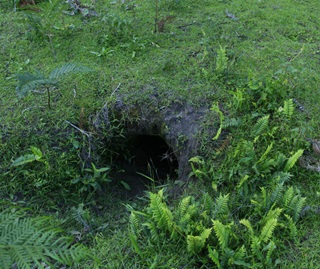What do they look like?
Wombats grow to about 1.3 metres in length and can weigh up to 36 kilograms. They have a large, blunt head with small eyes and ears and a short, muscular neck. Their sharp claws and stubby, powerful legs make them great diggers. Wombats have been known to live for up to 27 years in captivity.
There are 3 species of wombat, 2 of which occur in New South Wales:
- The bare-nosed wombat (Vombatus ursinus) is the most common and widespread wombat species in New South Wales and has a large, naked snout covered in grainy skin.
- The much rarer southern hairy-nosed wombat (Lasiorhinus latifrons) has larger ears than the common wombat, and its snout is coated with fine hairs. Until recently, the southern hairy-nosed wombat was thought to be extinct in New South Wales. It is currently listed as endangered.
- The northern hairy-nosed wombat (Lasiorhinus krefftii) is presumed extinct in New South Wales.
Threats
Because of settlement and agriculture, wombats in most areas have been pushed into the rugged hills and mountains. As long as they remain in these areas, wild dogs and collisions with cars are more of a threat to these marsupials than landowners. However, because of their habit of wandering down to the flats to enjoy the tasty morsels growing there (knocking down fences on the way), they are sometimes killed by farmers.
Wombats have also had to compete with introduced animals – such as cattle, sheep and particularly rabbits – for food. This competition appears to have been a major factor in the decline of the northern hairy-nosed wombat in New South Wales.
Wombats are protected under the NSW Biodiversity Conservation Act 2016. It is an offence to harm a wombat unless a licence is obtained from the Department of Climate Change, Energy, the Environment and Water.
Sarcoptic mange is an emerging infectious skin disease impacting wombats. It is caused by a mite (Sarcoptes scabiei). The mite burrows into the skin of its host, causing inflammation, thickening skin, hair loss and intense itchiness. Wombats are the protected species most severely affected by sarcoptic mange. It has significant health and welfare implications for individual animals and, if left untreated, affected wombats can become severely sick and die. The NSW Government is currently implementing a 2-year program to help curb wombat mange. The project commenced in early 2023 and will continue until 2024.
Curb Wombat Mange Program
Protection of native animals
All native birds, reptiles, amphibians and mammals, but not including dingoes, are protected in NSW by the Biodiversity Conservation Act 2016.








 The bare-nosed wombat lives mainly in wet, partly forested areas on the coast and on the ranges and western slopes. The southern hairy-nosed wombat prefers dry, open country.
The bare-nosed wombat lives mainly in wet, partly forested areas on the coast and on the ranges and western slopes. The southern hairy-nosed wombat prefers dry, open country.